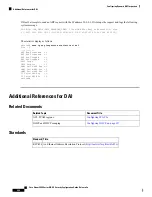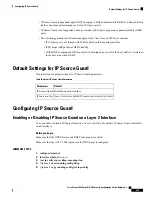
Untrusted
Interfaces that are connected to hosts or to devices that are not running DAI
Trusted
Interfaces that are connected to devices that are running DAI
When you cannot determine the bindings of packets from devices that do not run DAI, isolate at Layer 3 the
devices that run DAI from devices that do not run DAI.
Depending on your network setup, you may not be able to validate a given ARP packet on all devices in the
VLAN.
Note
Logging DAI Packets
Cisco NX-OS maintains a buffer of log entries about DAI packets processed. Each log entry contains flow
information, such as the receiving VLAN, the port number, the source and destination IP addresses, and the
source and destination MAC addresses.
You can also specify the type of packets that are logged. By default, a Cisco Nexus device logs only packets
that DAI drops.
If the log buffer overflows, the device overwrites the oldest DAI log entries with newer entries. You can
configure the maximum number of entries in the buffer.
Cisco NX-OS does not generate system messages about DAI packets that are logged.
Note
Licensing Requirements for DAI
This table shows the licensing requirements for DAI.
License Requirement
Product
DAI requires no license. Any feature not included in a license package is bundled with the
nx-os image and is provided at no extra charge to you. For an explanation of the Cisco NX-OS
licensing scheme, see the
Cisco NX-OS Licensing Guide
.
Cisco
NX-OS
Prerequisites for DAI
• You must enable the DHCP feature before you can configure DAI. See
• You must configure the VLANs on which you want to enable DAI. See the
Cisco Nexus 9000 Series
NX-OS Layer 2 Switching Configuration Guide
.
Cisco Nexus 9000 Series NX-OS Security Configuration Guide, Release 9.x
392
Configuring Dynamic ARP Inspection
Logging DAI Packets






























